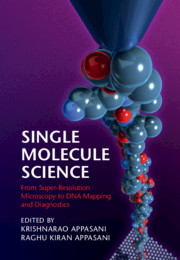Book contents
- Single-Molecule Science
- Single-Molecule Science
- Copyright page
- Dedication
- Contents
- Contributors
- Foreword
- Preface
- Part I Super-Resolution Microscopy and Molecular Imaging Techniques to Probe Biology
- Part II Protein Folding, Structure, Confirmation, and Dynamics
- 5 Single-Molecule Mechanics of Protein Nanomachines
- 6 Posttranslational Protein Translocation through Membranes at the Single-Molecule Level
- Part III Mapping DNA Molecules at the Single-Molecule Level
- Part IV Single-Molecule Biology to Study Gene Expression
- Index
- References
5 - Single-Molecule Mechanics of Protein Nanomachines
from Part II - Protein Folding, Structure, Confirmation, and Dynamics
Published online by Cambridge University Press: 05 May 2022
- Single-Molecule Science
- Single-Molecule Science
- Copyright page
- Dedication
- Contents
- Contributors
- Foreword
- Preface
- Part I Super-Resolution Microscopy and Molecular Imaging Techniques to Probe Biology
- Part II Protein Folding, Structure, Confirmation, and Dynamics
- 5 Single-Molecule Mechanics of Protein Nanomachines
- 6 Posttranslational Protein Translocation through Membranes at the Single-Molecule Level
- Part III Mapping DNA Molecules at the Single-Molecule Level
- Part IV Single-Molecule Biology to Study Gene Expression
- Index
- References
Summary
A single live cell of E. coli can be estimated to contain around 3 million active protein molecules at any given moment. For larger and more complex human cells, that number goes up to between 200 and 300 million (Milo and Phillips, 2015). In E. coli, this represents around 4,000 different types of proteins and in humans around 20,000 (Wang et al., 2015). Each of these proteins performs a different and highly specialized role within the living cell, determined by its three-dimensional structure, composition, mechanics, and dynamics. Very few experimental techniques are able to access information about the structure and dynamics of the individual elements and substructures of protein molecules, which is needed to understand aspects of their function. One such technique is single-molecule force spectroscopy by optical trapping, a method for which Arthur Ashkin won the Nobel Prize in Physics in 2018. Using the principle that highly focused laser beams can be used to trap micron-scale objects, experimental methods have been developed where micron-sized glass beads are functionalized with protein constructs, establishing geometries that enable forces to be applied to the individual protein molecules (Figure 5.1a).
- Type
- Chapter
- Information
- Single-Molecule ScienceFrom Super-Resolution Microscopy to DNA Mapping and Diagnostics, pp. 67 - 79Publisher: Cambridge University PressPrint publication year: 2022

